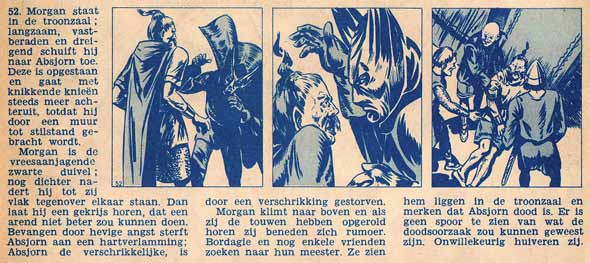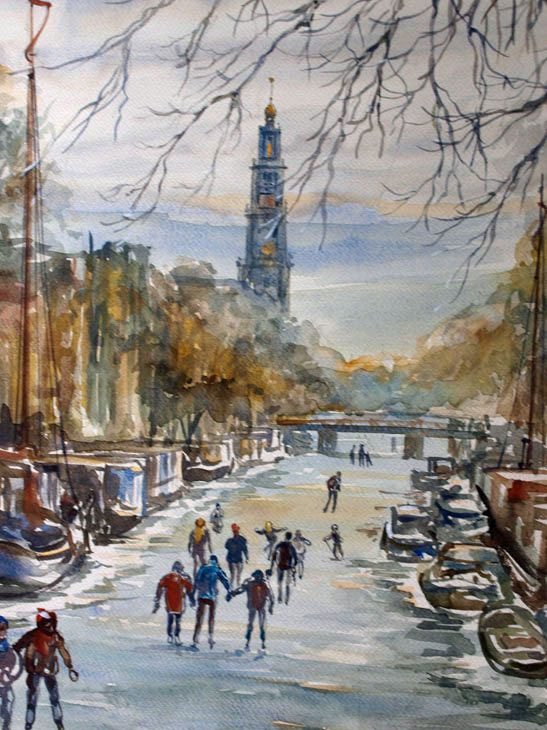'Linda Lucardy, de Vliegende Stewardess' (1954).
Henk Alleman was a Dutch painter and cartoonist. His career in comics was centered in the 1950s, when he was affiliated with the Swan Features Syndicate and the magazines of the publishers Rotogravure and De Spaarnestad. Working in several genres, his comics include 'Morgan Bloomsbury, de Prins uit Engeland' (1947), 'Tommie', 'Linda Lucardy, de Vliegende Stewardess' (1954-1955), 'Operatie Burn-Out' (1957-1959) and several comic adaptations of literary classics. Alleman then switched to working as a sales representative, until he turned to fine art painting in the 1980s.
Early life
Henk Alleman was born in 1928 in Amsterdam. He grew up in the "Indische Buurt" neighborhood in the city's eastern part. His father was a former sailor, who now worked as a waiter in restaurants. Growing up poor, much of his childhood was spent on the streets, playing with friends. One of these neighborhood friends was the future comic artist Piet Wijn. Henk Alleman and his three brothers all developed a talent for drawing and interest in art. Henk's older brother Han (1 August 1924 - 1 February 2003) attended the Don Bosco drawing school and transferred most of his acquired knowledge to his younger sibling, while also fuelling Henk's interest in world history. A couple of years after his brother, Henk Alleman took evening classes at Don Bosco as well, where he learned more about human anatomy and the muscular system. Other than that, he was a self-taught artist. Among his main influences were the American newspaper cartoonists Alex Raymond, Hal Foster and Milton Caniff, as well as the comics about Native American by José Luis Salinas. Henk Alleman spent most of his adult life living in the Reguliersdwarsstraat, a street in Amsterdam's city center, and then in the Amsterdam Buitenveldert neighborhood.
'Morgan Bloomsbury' (1947).
Toonder Studio's
Alleman's father was a big fan of Marten Toonder's 'Tom Poes' comic in newspaper De Telegraaf. In 1942 he noticed an ad asking for artists for the animated film productions of Geesink-Toonder Tekenfilmproducties, a studio led by Joop Geesink and Toonder. Both Alleman and his brother Han applied and were hired. Fourteen years old, Henk started out as "tekenaar-volontair". He liked the French-sounding job title, only to find out at the end of the month that it meant "volunteer artist" - a trainee without pay! Alleman complained, and managed to persuade Marten Toonder to get him on the payroll as well. He participated as a film cell inker in the production of 'Das Musikalische Auto', an advertising film commissioned by the Nazi production company UFA. After World War II, both the Alleman brothers returned to the Toonder Studio's to work on advertising films for Philips, starring Toonder's signature characters Tom Poes and Olivier B. Bommel (Tom Puss and Lord Bumble), including 'The Haunted Castle', 'The Magic Music' and 'Dreamland'. Henk Alleman had no participation in the studio's comic productions.
Freelance comic artist and illustrator for magazines
Work for the Toonder Studio's happened on an on-and-off again basis, so the Alleman brothers had to find additional work. Han Alleman turned to making saucy cartoons for Pin Up Magazine (using the pen name H. Aman), and then had a successful career as a retoucher of advertising drawings through his own Studio Flair. Henk Alleman turned to creating comics and tried to sell his stories to newspapers and magazines. At the time, he signed his work with "H. Allman" or "Henk Al". The Flemish children's magazine Kleine Zondagsvriend ran Alleman's 'Morgan Bloomsbury, de Prins uit Engeland' (1947), a chivalry story strongly inspired by Hal Foster's 'Prince Valiant', created by Alleman when he was nineteen years old.
Alleman then joined the Haarlem-based publishing house De Spaarnestad, making illustrations for serials in the women's weekly Libelle. In 1953 and 1954, he was additionally present in Libelle's children's supplement magazine Tombola, starting with 'De Negerhut van oom Tom' (1953-1954), a comic adaptation of Harriet Beecher Stowe's anti-slavery novel 'Uncle Tom's Cabin' (1852). After that, he drew the children's adventure comic 'Doctor Davis' (1954), written by journalist/novelist Toon Kortooms.
'De Negerhut van Oom Tom' (Tombola).
Around the same period, Alleman began making text comics for Eva, another woman's weekly, published by the Nederlandse Rotogravure Maatschappij in Leiden. For its children's section, he created five fantasy-filled adventure stories starring the character 'Tommie' (written 'Tommy' from the second story on). Another comic he developed for Eva was 'De Familie Elkerlik' (1954). On Eva's back page, he developed five dramatic adventures of air hostess 'Linda Lucardy, de Vliegende Stewardess' (1954-1955). Alleman's final comic serial for Eva was 'De Noodlottige reis van Marie Felice' (April-October 1958), a historical naval tale set on a four-masted clipper ship. A South African press agency showed interest in acquiring the story, and asked Henk Alleman to send his original drawings. After that, nothing was heard from them again, and the material was lost forever.
'Tommie en het Geheim van de Gouden Stad' (Eva, 1950s).
Swan Features Syndicate
By the mid-1950s, Alleman associated himself with the Swan Features Syndicate, a newspaper comic distribution agency led by Marten Toonder's former business partner, Anton de Zwaan. Several of the features Alleman developed became part of the syndicate's portfolio, but never saw publication. His collaboration with Elsevier journalist A. Duif for instance, the social satire 'Tante Toet en Krijn Krul', was about to be serialized in nine regional newspapers, but mutual disagreements ended these plans. 'Willy Woep en Pieter Kwiek' was never picked up by newspapers.During this period, Alleman's detective strip 'Dick Dalton, & the Special Agents' was created for the British market, but it probably never ran there. Four stories were serialized in the Dutch local newspaper Emmer Courant under the title 'Jack Hott', and by 1971, the feature was reprinted in another regional newspaper (presumably the Drachter Courant) under the title 'Dick Dalton, Speciaal Verslaggever'. In mid-1956, Henk Alleman temporarily succeeded Piet Wijn as creator of the magical medieval series 'Aram van de Eilanden', published in regional newspapers. Filling in halfway through the 19th story, 'Het Oog van Siva', Alleman produced four full episodes before Wijn returned to the feature in June 1957.
In 1957, Alleman launched his most successful newspaper comic, the futuristic sci-fi series 'Operatie Burn-Out - Op Weg Naar Vreemde Werelden' (1957-1959). Inspired by Alex Raymond's 'Flash Gordon' saga and the recent launch of the Sputnik 1, Alleman created a scientifically-funded newspaper comic about space travel in the year 2057. For the writing of the comic, Alleman got assistance from the journalists Bas Roodnat and Piet Mulder, while the necessary documentation and technical advise was provided by aerospace expert Walther de Kok. Five stories of 'Operation Burn-Out' were syndicated by Swan Features to newspapers in Belgium (Het Laatste Nieuws) and the Netherlands (Nieuwsblad van het Noorden). The titles were 'Het Stralende Eiland van Levanja', 'Venus, de Mysterieuze Planeet', 'De Bedreiging van Curca', 'Het Boze Oog van Luna' and 'De Ondergang van Empireum'. The series was even printed in newspapers from Yugoslavia and Russia, but, according to Alleman, clandestinely.
One of the final comic strips Henk Alleman developed was 'Mazurka, de Zwervende Zigeunerin', about a wandering Roma woman named Mazurka. It remained shelved because working on 'Operation Burn-Out' took up all of his time. Decades later, a restored version of the unfinished strip was published in the March 2014 issue of the Dutch comic news magazine Stripschrift.
'Mazurka, de Zwervende Zigeunerin' (1950s comic strip published in 2014 in Stripschrift #437).
Career change
In 1959, at age 32, Alleman radically changed his career path. A couple of commercial art assignments got him in touch with the director of the pharmaceutical company Kraepelien & Holm in Zeist. The man offered Alleman a job as sales representative for the factory's liquorice products, meaning a steady paycheck and company car. Since Alleman was now a father who had to support his family, he took the offer. After a couple of years, he switched to Shulton cosmetics in Leiden, distributor of grooming products like Old Spice.
Painting
Between 1959 and throughout the 1960s, 1970s and early 1980s, Alleman refrained from doing any artistic work. It wasn't until a 1982 Toonder Studio reunion in the Nederhorst den Berg castle - Marten Toonder had just turned 70 - that his old colleagues refueled his desire to draw and paint. From then on, Alleman picked up fine art painting, taking inspiration from the Romantic-Impressionist style (The Hague School), as well as geometric and experimental art. His best-known works became his paintings of historical and present-day Amsterdam street scenes. Over the years, they have been exhibited throughout the Amsterdam region, including the Glass House in the Amstelpark, the Hilton and Novotel hotels and the Slotervaart hospital. His work was sold through the Art Gallery in the Leidsestraat and the Fantasia comic shop in Amsterdam Buitenveldert. One of the people who bought a large Alleman oil painting was the beer tycoon Freddy Heineken. Besides painting, Alleman also returned to drawing, particularly making illustrations to accompany the historical stories he was writing in his spare time.
Recognition and legacy
Since 2016, the publishing house Boumaar has released limited edition book collections of Henk Alleman's old comic productions. In 2018, Alleman's sci-fi comic 'Operation Burn-Out' was included in the 'Comics in Space' exposition, held at the Space Expo center in Noordwijk and the Heroes Dutch Comic Con in Utrecht. As one of the last remaining pioneers of Dutch post-war comics, Alleman was awarded the 2019 Bulletje & Boonestaak Plate during the Stripdagen comics festival in Utrecht on 23-24 March 2019. He died in March 2023, at the age of 94.
Amsterdam painting by Henk Alleman.










